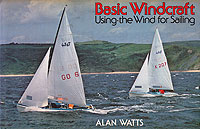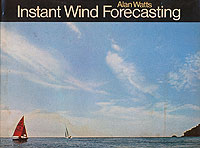|
Vaughan Family Timestream® Maps |
| Home Biography People Places Multimedia: Making It Work On the Water Writings/Presentations |

Note: Oceans was published five, then six times a year, originally by Trident Publishers, Inc, of San Diego, later by the Oceanic Society, finally by Oceans Magazine Limited Partnership for the Oceanic Society. Volume 1, Number 1 (January 1969) to Volume 21, Number 6 (November 1988).
Reading the Wind
Instant Wind Forecasting. By Alan Watts. New York: Dodd, Mead & Company. 1975. 120 pp., illustrations and color photographs. $7.95.
and
Basic Windcraft. By Alan Watts. New York: Dodd, Mead & Company. 1976. 96 pp., illustrations by Mary Sims. $5.95.
Reviewed in Oceans Magazine
By Tay Vaughan
January, 1977
In the last three years, that shelf in the chandlery or local bookstore devoted to maritime topics such as seamanship, meteorology, cooking at sea, and vessel maintenance, has multiplied into a whole subsection with many new names and titles, with beautiful color pictures, detailed drawings, and expensive prices.
Among these new books are five by the British meteorologist, Alan Watts. Two of these, Instant Wind Forecasting and Basic Windcraft, are representative of that genre of books whose content is understandable to the novice, yet presented in such a way as to provide meat for the more experienced. The books are neat and compact in format, and are easily taken aboard for reference.
While Watts admits to the danger of "compartmentalizing" the wind, he offers in both books a wonderfully alive array of basic explanations, practical suggestions, and illustrated situations. These books contain not only the usual Beaufort Scale and basic facts about isobars, but also such eye-catchers as "Recognizing and Using the Abnormal Tactical Airstream," "Shelter and Danger," "First Rule for Tacking in a Variable Wind" . . .
To some sailors, the difference between instant wind forecasting and windcraft is indistinguishable. To others, particularly dinghy and small boat racers, the difference is important, but often remains unconscious. Consistent race winners speak of a good "feel" for the wind, a developed sense of "smell," or an uncanny ability to "see" wind cells. Instant Wind Forecasting deals with predicting gross and fine wind patterns from manifest signs such as cloud type, pressure, terrain, time of day. Basic Windcraft (a term coined by Watts) treats tactical situations, teaching those delicate signs that others might miss to enable a sailor to pick his way advantageously through the shifts. Both volumes, of course, are closely associated.
The wind ". . . is an invisible man whose attributes and whereabouts are always directly veiled from us and only by observing other things can we see it moving here and ghosting there." Watts has indeed compartmentalized his invisible man into intelligible and practical categories of use to all sailors. Whether winning a dinghy race or cruising blue water or along foreign coasts, it is knowledge tempered by prudence and foresight that marks a good seaman. These books afford a great deal of information and some suggestions toward prudence, and they are, above all, good reading.

